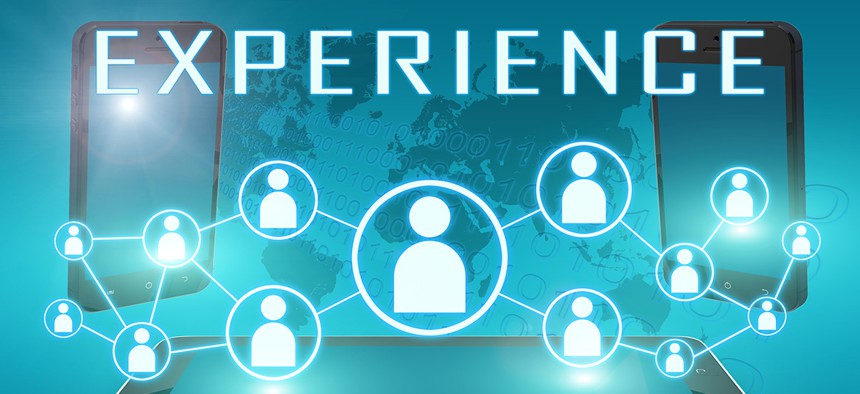Automating the Citizen Experience in Government

Mathias Rosenthal/Shutterstock.com
The public sector must support rapid procurement and integration of digital technologies to support citizen-centric experiences.
Teresa A. Weipert is senior vice president, Sutherland Government Solutions, a unit of Sutherland Global Services.
Last year at the annual World Economic Forum meeting in DAVOS, a pronouncement was made that the value of digital transformation—for society and the IT industry combined—could be greater than $100 trillion by 2025. That’s a staggering number!
Included in that transformation are digital technologies and cloud-based platforms, as well as analytics, sensors, mobile solutions and a new wave of automation that affects all industries and vertical markets, including financial, energy, security, communications and health.
» Get the best federal technology news and ideas delivered right to your inbox. Sign up here.
While they may be early in their life cycles, all of these technologies already are making their mark on societies, economies and people’s lives.
But with the emergence of the digital era come expectations of accountability, transparency and service. Because industry has been the original catalyst for this transformation, companies have come to recognize the importance of customer experiences in the digital marketplace. Customers want to be informed, and they seek real-time interaction, real-time results.
Delivering excellent customer service requires using newer technologies, integrating existing tools and platforms, and process maps that connect all these elements to deliver results. This is not an easy step, especially while keeping existing operations moving forward; it’s much harder to understand and use the new automated platforms while simultaneously designing, servicing, sustaining and analyzing one’s own digital transformation.
And that’s just the private sector.
In the public sector, these emerging technologies will enhance the citizen experience (as long as agencies can manage their budgets). Government and citizens, ordinary folks like you and me, have watched industries successfully implement digital-channel contact centers, phones, websites, social media, email, chatbots, texts, mobile apps and virtual avatars, all as mechanisms to interact with customers and improve their overall experiences.
Now, it’s time for those interaction touch points to be adapted to citizens’ experiences with government. While industry and government may differ in mission, they share a similar objective: to deliver a quality customer/citizen experience.
Multichannel citizen engagement—also called omni-channel engagement platform—is a trend moving from the commercial world into government to accomplish this. The omni-channel platform provides a single 360-degree view of the customer across a multitude of work environments and support channels.
For instance, my company has developed a platform used by Fortune 100 companies called the Sutherland Customer Analytics Network 360. It was developed to automate and incorporate processes, technology applications and databases, simultaneously processing millions of transactions. SCAN 360 is a cloud-based platform designed to continually optimize customer experiences through the application of advanced big data analytics, human cognition, robotic process automation, machine learning, artificial intelligence and other emerging technology capabilities such as virtual avatars.
Using these new platforms and engagement methodologies is based on some foundation principles:
- We listen to our customers.
- We understand their journey (market-related and operations) and anticipate their needs.
- We deliver a seamless “engagement experience.”
- We analyze everything.
- We get better at it!
These principles stay constant, even as the digital era brings the internet of things, robots and supercomputing, to name a few.
The omni-channel automated engagement platform will provide metrics and actionable insight to government agencies for optimizing the citizen experience and improving relationships with constituents.
This is especially important because people are more social, more mobile, more tech-savvy and much more demanding than in the past. Failing to meet their expectations, or misjudging the nuances of individuals’ situations, could damage agencies’ reputations and their ability to deliver services.
Using the omni-channel platform provides a mechanism, through its analytics, to measure success and reward excellence in service and professionalism by government employees.
The government’s next step is to incorporate this kind of automation rapidly, to better address constituent needs in the digital era. The White House document, “Digital Government: Building a 21st-Century Platform to Better Serve the American People,” is the road map for the challenges of the emergence of digital government:
[B]uilding for the future requires us to think beyond programmatic lines. To keep up with the pace of change in technology, we need to securely architect our systems for interoperability and openness from conception. We need to have common standards and more rapidly share the lessons learned by early adopters. We need to produce better content and data, and present it through multiple channels in a program and device-agnostic way. We need to adopt a coordinated approach to ensure privacy and security in a digital age.
To meet these goals for digital government, the private sector can provide lessons-learned with proven applications. Also, omni-channel automated engagement platforms have been designed with multiple channels, interoperability and cybersecurity as integral components from conception; this contrast directly with the lack of efficient operational structures and patched-together cybersecurity currently the status quo in many government legacy systems.
The last, maybe most important, imperative is an overhaul of government procurement policies and procedures. The White House also addressed that issue in its digital strategy, suggesting a shift to an enterprisewide asset management and procurement model. The administration believes moving to an enterprisewide model will allow agencies to leverage economies of scale and streamline purchasing, invoicing and asset management processes.
If the public sector is going to keep up with the staggering pace of digital transformation and apply it to citizen-centric experiences, it must support rapid procurement and integration of digital technologies, whether existing, new or emerging.






 By
By